A confined micro-reactor with a movable Fe3O4 core and a mesoporous TiO2 shell for a photocatalytic Fenton-like degradation of bisphenol A
2021-10-14PengpengQiuToZhoXiohngZhuBinotThokchomJinpingYngWnJingLinjunWngYuchiFnXiopengLiWeiLuo
Pengpeng Qiu,To Zho,Xiohng Zhu,Binot Thokchom,Jinping Yng,Wn Jing,Linjun Wng,Yuchi Fn,Xiopeng Li,*,Wei Luo,*
a State Key Laboratory for Modification of Chemical Fibers and Polymer Materials, College of Materials Science and Engineering, Institute of Functional Materials, Shanghai 201620, China
b Indian Institute of Technology Guwahati, Guwahati 781039, India
ABSTRACT Photocatalysis and Fenton process are two primary and promising advanced oxidation processes to degrade organic pollutants.However, the practical applications of single photocatalysis and Fenton process are still limited.Introducing one of them into another to form a combined photocatalytic Fentonlike system has shown great potential but still faces challenges in designing a well-tailored catalyst.Herein, a confined photocatalytic Fenton-like micro-reactor catalyst with a movable Fe3O4 core and a mesoporous TiO2 shell has been constructed via a successive Stöber coating strategy, followed by an ultrasound assisted etching method.The resulting micro-reactor possesses well-defined yolk-shell structures with uniform mesopores(~4 nm),a large Brunauer-Emmett-Teller(BET)surface area(~166.7 m2/g), a high pore volume (~0.56 cm3/g) and a strong magnetization (~51 emu/g), as well as tunable reactor sizes(20-90 nm).When evaluated for degrading bisphenol A under solar light in the presence of peroxymonosulfate,the micro-reactor exhibits a superior catalytic degradation performance with a high magnetic separation efficiency and an excellent recycle ability.The outstanding performance can be attributed to its unique textual structure,which leads to a great synergistic effect from the photocatalytic and Fenton-like process.This study gives an important insight into the design and synthesis of an advanced micro-reactor for a combined advanced oxidation processes (AOPs).
Keywords:Photocatalytic Fenton-like reaction Yolk-shell Micro-reactor Magnetic Mesoporous
Emerging organic contaminants (EOCs) are a kind of contaminants that are not regularly detected but they have high tendency to spread into the environment, which exhibit great potential to cause adverse effects to the ecology and human health.The EOCs are mainly divided into endocrine disruptors,pharmaceuticals and personal care products, surfactants, and various industrial additives as well as hormones [1-3].Bisphenol A (BPA), classified as an endocrine disruptor, is a tricky pollutant since it has been widely applied in the production of polycarbonates,epoxy resins,and other plastics over the past decade.More importantly, some traditional treatment technologies including adsorption, membrane filtration, and biological treatment are usually restricted to treat them owing to the ultralow concentration, high chemical stability and low biodegradability of BPA [4,5].As an alternative,advanced oxidation processes (AOPs) have attracted tremendous research interest for the decomposition and mineralization of them through some strong oxidative species such as·OH,·O2[6-9].
Among various AOPs, Fenton-like process based on Fe2+and peroxymonosulfate (PMS) has recently triggered tremendous research interest because of its environmental benignity and cost effectiveness [10-12].However, the practical application of it is still limited by several drawbacks,such as the narrow operating pH range, hard to recycle the soluble metal ions and necessity for further treatment of sludge[13,14].To address these problems,the fabrication of a magnetic catalyst is desirable.Up to now,magnetite nanoparticles (NPs) have been widely investigated as one of the most efficient heterogeneous Fenton catalysts among Fe-based nanomaterials due to their higher content of structural Fe2+[15-17].However, compared with the homogenous Fenton reaction,the catalytic performance of Fe3O4NPs based one is still far from expected.Recently, the hybridization of Fenton reaction with photocatalytic process has shown great potential in this field[18-20].However,the development of a catalyst that could achieve both high Fenton-like and photocatalytic performance is still challenging.
Herein, a unique yolk-shell structured magnetic mesoporous TiO2has been synthesized through a facile ultrasound assisted etching method and demonstrated as a highly efficient solar photocatalytic Fenton-like catalyst for degrading BPA.The resultant material exhibits a unique yolk-shell structure with uniform mesopores (~4 nm), a large Brunauer-Emmet-Teller (BET) surface area(~166.7 m2/g),a high pore volume(~0.56 cm3/g)and a strong magnetic susceptibility (~51 emu/g).More importantly, the void space can be facilely tuned from 20 nm to 90 nm by changing the thickness (10-46 nm) of SiO2middle layer, which can act as a superior micro-reactor for the confined photocatalytic Fenton-like degradation of BPA.
The schematic illustration for the synthesis of yolk-shell structured magnetic mesoporous TiO2micro-reactor are illustrated in Scheme 1.The uniform magnetite NPs are first fabricated via a facile solvothermal method,which involves the reduction of Fe(III)salts with ethylene glycol at a high temperature (200。C) in the presence of sodium citrate as a capping agent.Scanning electron microscope(SEM)images clearly show that the Fe3O4NPs exhibit uniform spherical shapes with an average size of ~130 nm(Figs.S1A and B in Supporting information).Owing to the presence of abundant citrate groups on the surface, the NPs possess outstanding dispersibility in water or ethanol, which is very favorable for the subsequent high-quality coating with SiO2and TiO2.After the first Stöber coating, the Fe3O4@SiO2nanospheres with a smooth surface and a particle size of ~200 nm can be obtained (Figs.S1C and D in Supporting information).Transmission electron microscopy(TEM)images reveal that a ~35 nm thick SiO2layer is evenly wrapped on the Fe3O4core, forming a welldefined core-shell structure.The further Stöber coating gives rise to a sandwich-like Fe3O4@SiO2@TiO2nanostructure with a uniform TiO2layer(~35 nm)coated on the Fe3O4@SiO2cores(Figs.S1E and F in Supporting information).Following an ultrasound (US)assisted etching process in a weakly basic condition, the SiO2middle layer in the Fe3O4@SiO2@TiO2nanospheres can be completely removed, thus forming the void space between Fe3O4core and TiO2shell.Note that the US can also cause the further hydrolysis of Ti-OR moiety in the TiO2shell to become complete hydrolyzed form of Ti-OH, leading to the formation of mesoporous structure.The TEM images clearly show that the welldefined yolk-shell nanostructures with a movable black core is obtained (Figs.1A and B) The overall spacing is measured to be~70 nm, that equals the thickness of double silica interlayers,indicating that the silica was completely removed in NaHCO3solution under US irradiation.No Si peak was detected in the X-ray photoelectron spectroscopy(XPS)analysis,further suggesting the complete removal of SiO2(Fig.S2 in Supporting information).After calcination at 550。C for 2 h, mesoporous TiO2micro-reactor with uniform yolk-shell structure was obtained with a highly crystalline TiO2shell.High resolution TEM (HRTEM) image of the Fe3O4@-SiO2@c-mTiO2-3 clearly shows that the TiO2shell is well crystalized with a d-spacing of 0.35 nm, which is a typical reflection of anatase TiO2(Fig.1C).Moreover, the size of the void space can be facilely tuned from 20 nm to 90 nm by adjusting the thickness of SiO2interlayer from 10 nm to 45 nm (Figs.1D-F).In previous studies[11],the collapse could occur if the etching of SiO2did prior to the calcination.However,in our study,the collapse was not observed possibly because the post-hydrolysis of TiO2shell lead to the formation of void space in the network, which could buffer the thermal expansion during calcination, thus increasing the thermal stability of TiO2shell.The yolk-shell structured sample with different void space size of 20, 40, 70, 90 nm are denoted as Fe3O4@void@c-mTiO2-1, Fe3O4@void@c-mTiO2-2, Fe3O4@void@cmTiO2-3, Fe3O4@void@c-mTiO2-4, respectively.
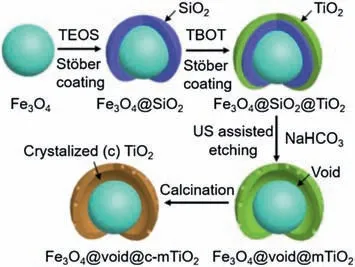
Scheme 1.Schematic illustration for the synthesis of magnetic mesoporous TiO2 micro-reactor.
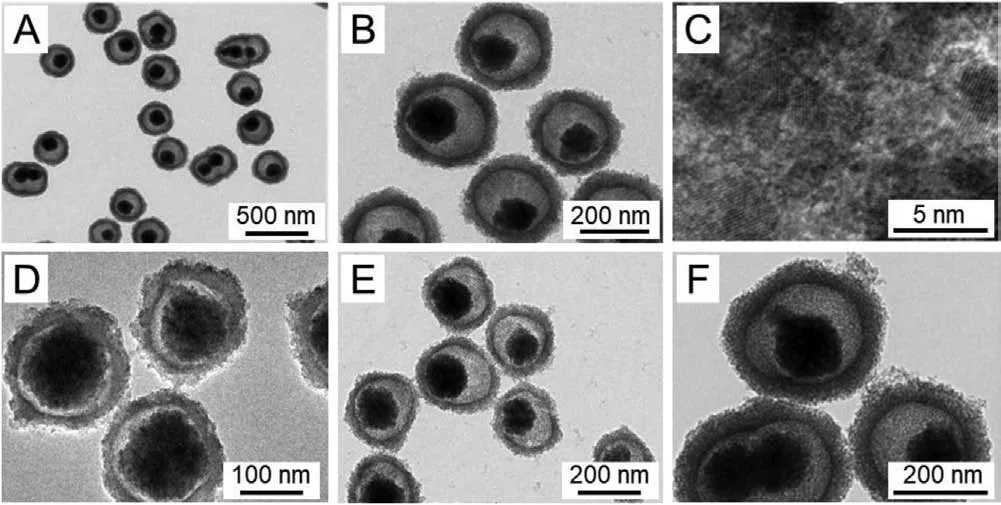
Fig.1.TEM(A and B)HRTEM(C)images of Fe3O4@SiO2@c-mTiO2-3 and TEM images of Fe3O4@SiO2@c-mTiO2-1 (D), Fe3O4@SiO2@c-mTiO2-2 (E) and Fe3O4@SiO2@cmTiO2-4 (F).
N2adsorption-desorption isotherms of the yolk-shell Fe3O4@-void@c-mTiO2-3 NPs(Fig.2A)depict an IV curve with a hysteresis loops close to H1-type, indicating that the TiO2shells contain uniform mesopores.The BET surface area and pore volume of the Fe3O4@void@c-mTiO2-3 sample are measured to be ~166.7 m2/g and ~0.56 cm3/g, respectively.Correspondingly, the pore size distribution(Fig.2B)calculated from the adsorption branch using the Barrett-Joyner-Halenda (BJH) method reveals a uniform pore size centered at ~4.2 nm.
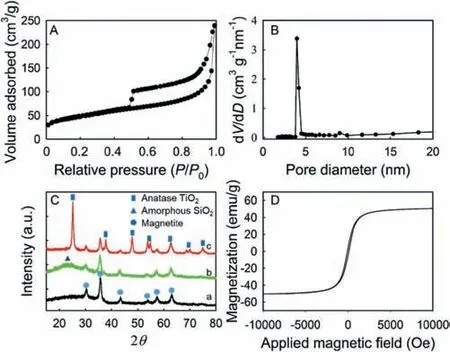
Fig.2.N2 sorption isothermals (A) and pore size distribution (B) of yolk-shell structured mesoporous TiO2 with a void space of 35 nm.XRD patterns(C)of Fe3O4(a),Fe3O4@SiO2(b),and Fe3O4@void@mTiO2-3(c).The magnetic hysteresis loops at 300 K of Fe3O4@void@mTiO2-3 (D).
X-ray diffraction (XRD) pattern of the Fe3O4nanoparticles(Fig.2C) exhibits several well resolved characteristic diffraction peaks,typical for Fe3O4crystalline phase.A broad amorphous silica peak can be clearly observed in the XRD pattern of Fe3O4@SiO2compared with that of pure Fe3O4NPs, suggesting that the SiO2was coated.No amorphous SiO2peak was observed in the sample of Fe3O4@void@mTiO2-3,suggesting that the SiO2middle layer was well removed.In addition,several sharp peak attributed to anatase TiO2was detected, proving that the mesoporous TiO2shell was well crystalized.The magnetic property of the Fe3O4@void@cmTiO2-3 micro-reactor was evaluated by measuring the magnetization saturation value (Fig.2D).As a result of the high magnetization (~51 emu/g), the Fe3O4@void@c-mTiO2-3 nanospheres in their homogeneous dispersion can be quickly recycled by applying a hand-held magnetic bar(<30 s,Fig.S3 in Supporting information).
The photocatalytic Fenton-like degradation performance of BPA in the presence of the resultant magnetic mesoporous TiO2was tested at a neutral pH(Fig.3A).Before the irradiation of solar light,the system was mechanically stirred in dark for 1 h to achieve an adsorption-desorption equilibrium between the catalyst and BPA.As a control, the degradation performances of BPA under PMS,solar/PMS, solar/catalyst, and PMS/catalyst conditions were also examined,showing the removal efficiencies of 17.0%,44.5%,76.1%,87.1%,respectively.The larger degradation efficiency of solar/PMS process than PMS alone was due to the dissociation of PMS into sulfate radicals through light [21].When Fe3O4@void@c-mTiO2-3 micro-reactor were directly used as a Fenton-like catalyst without solar light,the efficiency was significantly improved resulted from the activation of PMS by the surface Fe2+.Interestingly, when combine solar light, PMS and Fe3O4@void@c-mTiO2catalyst together, the degradation performance of BPA can be greatly promoted, which can achieve a complete degradation within 40 min, demonstrating the priority of this combined process.To better illustrate the priority of the combined process,a synergetic factor (S) has been introduced, which can be calculated based on Eq.1 [22-24].

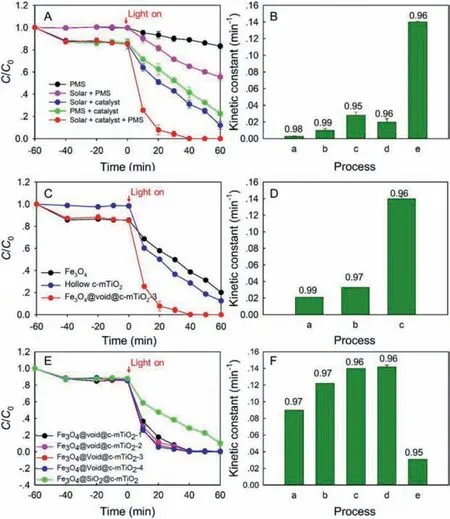
Fig.3.Photocatalytic Fenton degradation performance for BPA with different processes (A) and corresponding kinetic constant value (B); in B, PMS (a), Solar+PMS (b),Solar+catalyst(c),PMS+catalyst(d),and Solar+catalyst+PMS(e).Photocatalytic Fenton degradation performance for BPA(C)and corresponding kinetic constant value(D)in the presence of different catalysts; in D, Fe3O4 (a), Hollow c-mTiO2-2 (b), and Fe3O4@void@c-mTiO2-3 (c), Fe3O4@void@c-mTiO2-4 (d) and Fe3O4@SiO2@c-mTiO2 (e).Photocatalytic Fenton degradation performance for BPA (E) and corresponding kinetic constant value (F) in the presence of catalysts with different void space; in F,Fe3O4@void@c-mTiO2-1 (a), Fe3O4@void@c-mTiO2-2 (b), Fe3O4@void@c-mTiO2-3 (c), Fe3O4@void@c-mTiO2-4 (d) and Fe3O4@SiO2@c-mTiO2 (e).
Where, k1and k2is the kinetic constants of Fenton-like and photocatalytic process, respectively.k12is the kinetic constant of the combined photocatalytic Fenton-like process.The kinetic constants were calculated by fitting the experimental data with Langmuir-Hinshelwood model.The pseudo first order reaction equation was assumed because the concentration of BPA is very low.The correlation coefficients (R2) for all the process are above 0.95,suggesting that the assumption is reasonable(Fig.3B).The S is calculated to be 2.9, much larger than 1, suggesting that the combined process is not a simple sum of photocatalytic and Fenton-like process.The total leached iron ions concentration after the reaction was also measured at the neutral condition(Fig.S4 in Supporting information).We found that when only the catalyst was added to the system, negligible iron ions was detected,suggesting that the catalyst is stable.After the irradiation of solar light, the concentration of leached Fe ions increased, which is possibly due to that the structural Fe3+ions on the surface of Fe3O4lose their stability after scavenging the photo-excited electrons and thus get detached from the surface and then leached into the solution(Fig.S4b).The combination of PMS with the catalyst could also lead to the generation of a small amount of leached Fe ions,resulted from the mutual activation of PMS and catalyst surface.When combining these three together, the concentration of more than 20 times larger for leached Fe ions was detected,suggesting a strong synergistic interaction between these elements.This agrees well with the performance results.To demonstrate the superiority of the micro-reactor system, the degradation performances of individual Fe3O4and hollow structured mesoporous c-mTiO2(Fe3O4was etched out by a hot HCl solution)under solar light in the presence of PMS were also examined.It is clearly shown that both the photocatalytic Fenton-like degradation performances of Fe3O4and hollow structured mesoporous c-mTiO2are much smaller than that of the Fe3O4@void@c-mTiO2-3 micro-reactor, indicating that necessity to construct such a catalyst (Fig.3C).In addition, the photocatatyic performance of hollow structured mesoporous cmTiO2in the presence of PMS is larger than that without PMS,revealing that PMS also promote the photocaltyic reaction owing to the scavenge of photo-excited electrons (Fig.S5 in Supporting information).According to the calculated kinetic constant(Fig.3D), the synergistic factor is derived to be 2.5, further revealing the great enhancement after combining Fe3O4and hollow c-mTiO2together.
The effect of void size on the degradation performance was also evaluated(Figs.3E and F).It is clear that the core-shell structured Fe3O4@SiO2@c-mTiO2without etching out the SiO2interlayer shows a much smaller photocatalytic Fenton-like degradation performance than that the samples with void space, suggesting that the void space plays an important role in promoting the catalytic performance.This is because the presence of void space can not only increase the number of exposed reactive sites of inner core, thus facilitating the Fenton-like catalytic performance, but also promote the enrichment of the organic pollutants and PMS in the void space, bringing the synergistic effects between the photocatalytic and Fenton-like catalytic process.We also found that the photocatalytic Fenton-like degradation rate of BPA increased with the increase of void space size.This result is reasonable because larger void possess more space for the confined reaction between the photocatalytic and Fenton-like reaction.However,further increasing the void space beyond 70 nm did not lead to a significant increase in the degradation reaction rate,possibly owing to that too large void space will also reduce the synergistic interaction between the two reactions.Therefore, the Fe3O4@void@c-mTiO2-3 was used for the subsequent test.
The pH is an important factor to be considered for the practical application of Fenton based process.Thus, the degradation performance of Fe3O4@void@c-mTiO2-3 was also investigated at different pH (Fig.4A).We found that in this system, the removal efficiency in both acidic and neutral condition is similar,indicating that this catalyst can work in a neutral pH, which is favorable for the practical application.However,the removal efficiency sharply decreased when the pH was adjusted to 10 possibly owing to the change of reaction mechanism.It is speculated that on the Fe3O4nanoparticles, the mechanism could be proposed as follows (Eqs.2-4) [25-27].Where, the ≡symbol indicates the species on the surface of Fe3O4nanoparticles.

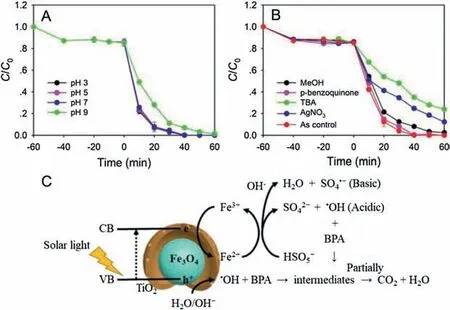
Fig.4.Photocatalytic Fenton degradation performance for BPA with at different pH(A)and in the presence of different scavengers(B).Schematically illustrate the mechanism for photocatalytic Fenton degradation of BPA in the presence of yolk-shell structured mesoporous TiO2 as the micro-reactor (C).
According to these equations,the reaction mechanism could be different at acidic and basic condition.At an acidic/neutral condition,the ferric ions could directly react with PMS to generate·OH(Eq.2).While in a basic condition,the system is abundant with negatively charged OH groups, which could be adsorbed on ≡Fe(II) ions to form ≡Fe(II)--OH complex.After addition of PMS,≡Fe(II)--OH on the catalysts could first react with HSO5-to generate ≡Fe(II)(HO)OSO3-(Eq.3) that subsequently decomposed to SO4·-(Eq.4).Consequently, Fe(II) would transform to Fe(III).Owing to the lower oxidation potential of SO4·-than·OH,thus the performance of this catalyst in basic condition is less effective than that in acidic condition.The recycling test of the Fe3O4@void@c-mTiO2-3 micro-reactor at pH 7 was also tested(Fig.S6 in Supporting information).After five recycles,no apparent decrease in the degradation kinetic constant was observed,indicating the excellent reusability of the catalyst.Both the SEM and TEM images of the recycled samples have shown that the welldefined core-shell structure were well retained, suggesting the excellent stability of the micro-reactor.However,the particle size of the inner magnetite cores slightly decreased,which is due to the iron leaching during the reaction.There is no clear change in the XRD pattern,revealing that the crystal structure of the catalyst was well maintained (Fig.S7 in Supporting information).To further clarify the reactive species involved in the reaction system, the scavenging tests were carried out in neutral condition(Fig.4B).The addition of a scavenger for·OH (tert-butyl alcohol) dramatically suppressed the combined photocatalytic Fenton-like reaction,suggesting that the·OH was the dominate species [28].A slight decrease of the degradation performance in the presence of pbenzoquinone (BQ) for·O2-, indicating that·O2-degradation was not significant [18].Besides, the introduction of AgNO3, as a scavenger for photo generated electrons(e-),had a strong effect on the performance for degrading BPA,suggesting that e-was also the dominate species.This is possibly because the addition of AgNO3scavenged the photo-generated electrons, thus inhibiting the recombination of photo-generated charges [29].This result is different from that occurs in photocatalytic process, holding the fact that if the Ag+consumed the electrons, more holes would survive and thus could generate more·OH.However, in this combined system, the Fenton-like reaction was also involved,which constructs the relationship with the photocatalytic process by scavenging the electrons with the Fe3+.The Ag+would capture most electrons because it has a higher oxidation potential than Fe3+and thus the interactions between the Fenton-like and photocatalytic process could be inhibited.While from the synergistic factor calculation, we can see that the performance enhancement from the synergy is much larger than that by the individual process.As a final result, the overall reaction rates are reduced upon the addition of Ag+.In the PMS involved Fenton reaction,the generation of SO4·-usually occurs.Therefore, the methanol(MeOH) was added to examine the effect of SO4·-.However, very little decrease in the degradation performance was found suggesting that SO4·-is not the directly reactive species responsible for BPA degradation [10,30].
Based on the results above,the mechanism can be explained by Fig.4C that BPA molecules are mainly degraded by·OH,which are produced by several pathways.The irradiation of solar light could excite the outer TiO2shell to generate photo-excited electrons and holes at the conduction band (CB) and valance band (VB),respectively.Then, the holes can react with the water molecules or OH-to generate·OH.At the same time,the ferric ion can activate the PMS to generate sulfate radicals and ferrous ions.At this moment, the ferrous ions plays an important role in keeping the interaction between the TiO2shell based photocatalytic and Fe3O4based Fenton process because on one hand,the Fe3+can scavenge the photo-excited electrons, thus greatly inhibiting the recombination of electrons and holes.Note that the PMS could also scavenge the photo-excited electrons, but from the experiment result(Fig.S5),the scavenge effect is not significant;on the other hand,the Fe3+can be recovered quickly to generate Fe2+to promote the Fenton-like reaction.It is well known that the lifetime of these radicals is very short,which can be easily recombined to form H2O2or SO42-, exhibiting a much smaller oxidation potential.The presence of void spaces can effectively reduce this effect because they can provide enough space to enrich the BPA modules to get close to the radicals, thus achieving an excellent degradation performance.Finally, the radicals can oxide the BPA molecules to small intermediates and then partially be mineralized into CO2and H2O, which has been proved by the total organic carbon (TOC)degradation test.
In summary, we have successfully prepared the yolk-shell structured Fe3O4@void@c-mTiO2micro-reactor through a combined Stöber coating method and an ultrasound assisted etching process.The Fe3O4@void@c-mTiO2NPs with a high specific surface area and a well-defined yolk-shell structure exhibit a remarkable performance for degrading BPA due to the synergic effect between the TiO2shells based photocatalytic process and the Fe3O4cores based Fenton-like reaction.More importantly, the void space can act as a micro-reactor, providing a special place for the catalytic reaction.Furthermore, the catalyst can work efficiently in both acidic and neutral condition.Owing to the high magnetization,the catalyst can be conveniently recovered by a hand-held magnet and be recycled for 5 times without significant loss of activity.This study provides a novel way for the design of unique micro-reactor catalyst for the photocatalytic Fenton-like reaction.
Declaration of competing interest
The authors declare that they have no known competing financial interests or personal relationships that could have appeared to influence the work reported in this paper.
Acknowledgments
This work is supported by the National Natural Science Foundation of China (Nos.5182220221972163 and 51772050),the Fundamental Research Funds for the Central Universities (No.2232020D-02), Shanghai Sailing Program (No.20YF1400500),Shanghai Natural Science Foundation (No.20ZR1401500), Shanghai Rising-Star Program (No.18QA1400100), Youth Top-notch Talent Support Program of Shanghai, Science and Technology Commission of Shanghai Municipality(No.19520713200),Shanghai Scientific and Technological Innovation Project (No.19JC1410400), Key Basic Research Program of Science and Technology Commission of Shanghai Municipality (No.20JC1415300), DHU Distinguished Young Professor Program and Fundamental Research Funds for the Central Universities.
Appendix A.Supplementary data
Supplementary material related to this article can be found,in the online version, at doi:https://doi.org/10.1016/j.cclet.2020.09.061.
杂志排行
Chinese Chemical Letters的其它文章
- Recent development of pillar[n]arene-based amphiphiles
- Recent advances in synthesis of organosilicons via radical strategies
- High thermal conductivity of graphene and structure defects:Prospects for thermal applications in graphene sheets
- Binder-free electrodes for advanced potassium-ion batteries:A review
- Sulfone-based high-voltage electrolytes for high energy density rechargeable lithium batteries: Progress and perspective
- Recent advances in fluorescence imaging of alkaline phosphatase
